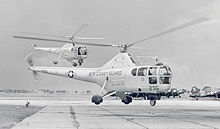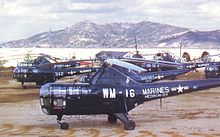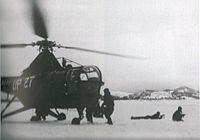


HO2S/R-5 (Sikorsky S-48) Dragonfly HELICOPTER
The Sikorsky H-5, (initially designated R-5[1] and also known as S-48, S-51 and by company designation VS-327[2]) was a helicopter built by Sikorsky Aircraft Corporation.
It was used by the United States Air Force, and its predecessor, the United States Army Air Forces, as well as the United States Navy and United States Coast Guard (with the designations HO2S and HO3S). It was also used by the United States Post Office Department.[3]
In December 1946, an agreement was signed between the British company Westland Aircraft and Sikorsky to produce a British version of the H-5, to be manufactured under license in Britain as the Westland-Sikorsky WS-51 Dragonfly. By the time production ceased in 1951, more than 300 examples of all types of the H-5 had been built.
The H-5 was originally built by Sikorsky as its model S-48,[4] designated as the R-5 by the United States Army Air Forces. It was designed to provide a helicopter having greater useful load, endurance, speed, and service ceiling than the Sikorsky R-4. The R-5 differed from the R-4 by having an increased rotor diameter and a new, longer fuselage for two persons in tandem,[2] though it retained the R-4’s tailwheel-type landing gear. Larger than the R-4 or the later R-6, the R-5 was fitted with a more powerful Wasp Junior 450-hp radial engine, and quickly proved itself the most successful of the three types.[5] The first XR-5 of four ordered made its initial flight on 18 August 1943. In March 1944, the Army Air Forces ordered 26 YR-5As for service testing, and in February 1945, the first YR-5A was delivered. This order was followed by a production contract for 100 R-5s, outfitted with racks for two litters (stretchers), but only 34 were actually delivered.[2] Of these, fourteen were the R-5A, basically identical with the YR-5A.[4] The remaining twenty were built as the three-place R-5D, which had a widened cabin with a two-place rear bench seat and a small nosewheel added to the landing gear, and could be optionally fitted with a rescue hoist and an auxiliary external fuel tank.[4] Five of the service-test YR-5As were later converted into dual-control YR-5Es.[2] The United States Navy evaluated three R-5As as the HO2S-1.[2]
Sikorsky soon developed a modified version of the R-5, the S-51, featuring a greater rotor diameter, greater carrying capacity and gross weight, and a redesigned tricycle landing gear configuration; this first flew on 16 February 1946.[2] With room for three passengers plus pilot, the S-51 was initially intended to appeal to civilian as well as military operators, and was the first helicopter to be sold to a commercial user.[6] Eleven S-51s were ordered by the USAF and designated the R-5F, while ninety went to the Navy as the HO3S-1, commonly referred to as the ‘Horse’.[2]
In Britain, Westland Aircraft began production in 1946 of the Westland-Sikorsky S-51 Dragonfly for the Royal Navy and the Royal Air Force, all of which were powered by a 500 hp Alvis Leonides engine. This gave an improved top speed of 103 mph and a service ceiling of 14,000 ft. In total, 133 Westland-Sikorsky Dragonfly helicopters were built. A considerably modified version was also developed by Westland as the Westland Widgeon, but the type was never adopted for service.[citation needed]
The U.S. Navy ordered four S-51s “off-the-shelf” from Sikorsky in late 1946 for use in the Antarctic and Operation Highjump, placing them into naval inventory as the HO3S-1.[7] Carried aboard the seaplane tender USS Pine Island, on Christmas Day 1946 an HO3S-1 of VX-3 piloted by Lieutenant Commander Walter M. Sessums became the first helicopter to fly in the Antarctic. Having proved its capabilities, the initial naval HO3S-1 order was followed by subsequent purchases of an additional 42 aircraft in 1948.[8] The Navy equipped several warship classes with HO3S-1 utility helos, including aircraft carriers, seaplane tenders, icebreakers, Des Moines-class cruisers, and Iowa-class battleships. By February 1948, the Marine Corps had equipped HMX-1, its first regular Marine Helicopter Transport Squadron, with six HO3S-1 aircraft. With a passenger load of only three lightly dressed persons, the HO3S-1s were primarily operated in the utility role by the marines; for the transport role, an additional nine tandem-rotor Piasecki-built HRP-1 helicopters were later added to the squadron.[9] Eventually, the U.S. Navy would acquire a total of 88 HO3S-1 (S-51) helicopters.[citation needed]
Thirty-nine additional specialized rescue helicopters were built, as the H-5G, in 1948, while 16 were fitted with pontoons as the H-5H amphibian in 1949.[2]
U.S. Air Force H-5 Dragon takes off post-World War II.
Several H-5Hs were converted in 1949 to a unique medical-evacuation role, with casualty stretchers loaded sideways through blister-hatches on the side of the fuselage. The back stretcher station was located just forward of the tail boom and the main stretcher station was located behind the crew cabin. The forward stretcher station could accommodate two casualties, who were accessible to the medic in flight, while the back stretcher station handled only one, not accessible to the medic during the flight. Very little information is known about the operational use of this modification by the USAF, this being abandoned shortly after tests in 1950.[10]
The R-5 had been designated under the United States Army Air Forces system, a series starting with R-1 and proceeding up to about R-16. In 1947 with the start of the United States Air Force, there was a new system, and many aircraft, but not all, were redesignated. The R-5 became the H-5. The United States Army broke off with its own designation system in the 1950s, resulting in new designations for its helicopter projects.[11] In 1962 under the new tri-service system (see 1962 United States Tri-Service aircraft designation system), many navy and army aircraft were given the low numbers. Under the 1962 system, the low H numbers were given to new aircraft. For example, H-5 was given to the OH-5, a prototype design which never entered Army service.
During its service life, the H-5/HO3S-1 was used for utility, rescue, and mercy missions throughout the world, including flights during Operation Highjump in the Antarctic. While the extra power of the H-5 made it significantly more useful than its R-4 and R-6 cousins, the H-5/HO3S-1 suffered, like most early small tandem-seat single-rotor machines, from center of gravity problems. As a matter of routine, the helicopter was equipped with two iron-bar weights – each in a canvas case – one of 25 lb (11 kg) & one of 50 lb (23 kg). Flying with no passengers, both weights were placed forward alongside the pilot. With three passengers, both weights were normally placed in the baggage compartment. However, in conditions of high ambient temperatures, which reduced lift due to the lowered air density, all weights were jettisoned. If the weights could not be recovered later, pilots on future missions were forced to utilize rocks or other improvised weights next to the pilot after offloading three passengers, or else travel at a very slow 25 knots (46 km/h; 29 mph).[12]
The H-5/HO3S-1 gained its greatest fame during the Korean War when it was called upon repeatedly to rescue United Nations pilots shot down behind enemy lines and to evacuate wounded personnel from frontline areas. It was eventually replaced in most roles by the H-19 Chickasaw.[citation needed] In 1957, the last H-5 and HO3S-1 helicopters were retired from active U.S. military service.[
